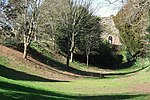Millbrook House
Millbrook House is a training centre for disabled people in Exeter, Devon, England founded in 1937 by Dame Georgiana Buller. It was the first school dedicated to occupational therapy training in the United Kingdom. The first intake of students began their training on 27 September 1944. The school became affiliated with the University of Exeter and the university validated all its courses. It was later renamed St Loye's College for Training the Disabled. In 1999 the school changed its name to St Loye's School of Health Studies in order to reflect its commitment to a wide range of health and social courses while still retaining its commitment to providing occupational therapy education. Since 2003 St Loye's has been part of the School of Health Professions of the University of Plymouth.
Excerpt from the Wikipedia article Millbrook House (License: CC BY-SA 3.0, Authors).Millbrook House
New North Road, Exeter Newtown
Geographical coordinates (GPS) Address Nearby Places Show on map
Geographical coordinates (GPS)
| Latitude | Longitude |
|---|---|
| N 50.7268 ° | E -3.5285 ° |
Address
New North Road 62
EX4 4EP Exeter, Newtown
England, United Kingdom
Open on Google Maps









